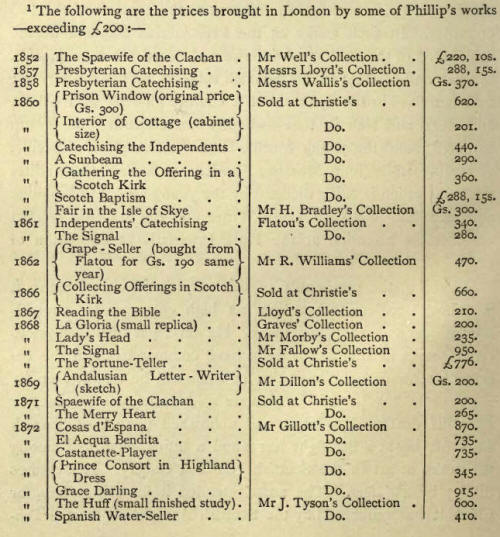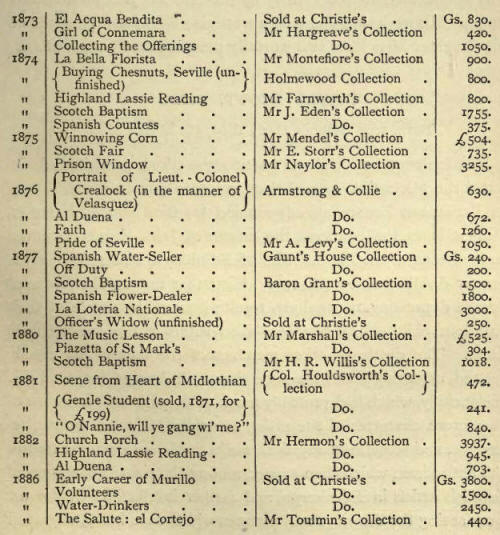|
JOHN PHILLIP, H.R.S.A., R.A.
Born, 22d May 1817;
died, 27th February 1867.
The similarity
of style between Scottish and Spanish art has already been referred to,
and it is remarkable that one of the most distinguished Scottish artists
should have found the subjects of his most notable and important works
in studies made among the Spanish people, after studying among his own.
Both Wilkie, and Roberts in architecture, found many of their subjects
in the romantic country of Spain; but Phillip has been most closely
identified with it, and his name cannot be recalled without this
association. In these works he has given a nationality and peculiar
animation, which even the great native artists have not surpassed: from
Velasquez and Murillo down to the latest painters of the Peninsula, none
have more faithfully and forcibly registered the genuine nationality;
and on no other grounds can this sympathetic feeling be explained, than
a similarity of character and disposition on the part of the Scot to the
Spaniard. John Phillip was a native of
Aberdeen, and like many other eminent artists, came of a humble
parentage. He was early in life apprenticed to a house-painter, and when
about the age of fifteen, made some attempt at picture-painting, by
trying to copy a sign-board containing a portrait of the Scottish hero
Sir William Wallace. Some interest was taken in the young artist by
Major Pryse Gordon, to whose house it is said Phillip was sent to
replace a broken pane of glass : the Major found, on coming into the
room, that the window was still unrepaired, on account of the young
glazier being unable to withdraw his attention from the pictures on the
walls. When about the age of seventeen he made his first visit to London
under rather disadvantageous circumstances; he hid himself on board a
brig sailing between Aberdeen and London, the master of which was an
acquaintance of his father, and on being discovered, was compelled to
pay for his passage by painting the ship's figurehead, and lifting
ballast for two days on the arrival of the brig at the port of London.
He managed to spend a whole day at the exhibition at Somerset House, and
had a glance at the National Gallery, after which he worked his passage
back again to Aberdeen. His early determination to become an artist was
strengthened by what he had seen, more especially the pictures of his
countryman Wilkie; and in the following year he painted an interior
containing twelve figures, one of the principal of which was a pedlar.
Major Gordon having noticed the progress of Phillip, mentioned his name
with high praise to Lord Panmure, who sent Gordon a cheque for to be
spent on behalf of the young artist, a portion of which sum was applied
towards the purchase of the Pedlar, afterwards given by Lord Panmure to
the Mechanics' Institute at Brechin, along with his Morning before the
Battle of Bannockburn, exhibited in 1843, and two cattle-pieces. He now
resided for some time with Major Gordon, who had sufficient taste to
direct to some extent his study, and through whose recommendation he
received several commissions for portraits: he had also during this time
the benefit of some instruction from a local painter named Forbes. About
1836 he migrated to London, when he appears to have been a pupil for a
very short time under Mr T. M. Joy, probably still under the patronage
of Major Gordon or Lord Panmure, and in the following year was admitted
into the school of the Royal Academy. He very soon, however, found
himself able to earn a living by portrait-painting, and in 1838
exhibited a portrait of a Young Lady at the Royal Academy. This was
followed by a Piper, and a sketch entitled Highland Courtship, at the
British Institution in 1839, in which year also he exhibited at the
Academy a Moor, and a portrait of W. Clerihew. He then returned to
Aberdeen, where he spent a few years, chiefly in portrait-painting.
During this time he exhibited the already- mentioned picture of the
Morning of Bannockburn, and afterwards, in 1846, finally returned to
London, where he exhibited his picture of Tasso in Disguise relating his
Story to his Sister. In the following years appeared numerous Scottish
subjects, which gradually made an impression on the public, the most
notable being the Presbyterian Catechising, the scene of which is the
interior of a farmer's house, exhibited in 1847; the Scotch Fair, 1848;
Drawing for the Militia, 1849; Scotch Baptism, 1850; a Scotch Washing
(engraved for the Glasgow Art Union, under the title of Heather Belles),
the Spaewife, and Sunbeam, in 1851. In 1847 at the British Institution
appeared two small pictures, Courtship, and the Grandfather, the latter
a composition of three figures. On account of his health having been
enfeebled by a severe illness, he made an excursion to the south of
Spain in 1851, remaining principally at Seville, where he passed some
seven or eight months.' This visit completely changed the whole current
of his art, and laid the foundation of his future fame by the study of
the picturesque people among whom he sojourned. Although he found the
attractions of nature in the streets and suburbs of the old towns of
Spain stronger than the interiors of the Spanish galleries, yet he did
not neglect these. Of the copies which he made then, the Surrender of
Breda, after Velasquez, was acquired at the sale of his works for the
Scottish National Gallery for £231; and at the same sale other two
copies from the same master (one of which is the famous picture of
Velasquez in his Studio) were acquired by the Council of the Royal
Academy. The abundant results of his first
journey to Spain enriched the future exhibitions of the Royal Academy,
where he exhibited, in 1853, Life among the Gipsies of Seville, full of
humour and variety; and the Perla de Triana, both pictures attracting
attention by their great richness of colour and able execution. Among
those in whom his works excited admiration was Sir Edwin Land- seer,
whose enthusiastic praise led her Majesty to purchase the Spanish Gipsy
Mother, and several of his sketches, besides giving him a commission to
paint his Letter-Writer of Seville, exhibited in the following year
along with his portrait of Lady Cosmo Russell. His powerful
character-picture representing the Collection in a Scotch Kirk,
exhibited in 1855, together with his other subjects from Scottish life,
showed the great development of his power acquired during and after his
Spanish visit; and in 1856-57 he was again in the Peninsula, this time
accompanied by his friend and fellow-artist Ansdell. At this period he
produced his picture entitled Aqua Fresca, representing Muleteers
halting at a well on one of the bridle-roads of Spain; the Prayer of
Faith shall save the Sick, a scene in a Spanish church, which received
much praise from Dr Ruskin; a portrait of Senorita de Gayangos, entitled
Doha Pepita; and the Gipsy Water-Carrier of Seville. He sometimes
wrought on the same canvas in conjunction with Ansdell, who painted the
animals: the first picture thus painted was the Wayside in Andalusia, a
joint commission from their mutual friend Mr Rawlinson. In the year 1857
he exhibited his Prison Window, and Charity, and was elected Associate
of the Royal Academy. The following year he exhibited his important
picture of the Spanish Contrabandista, now in her Majesty's possession;
El Cortejo; Youth in Seville; a portrait of the Prince Consort in
Highland costume, painted for the city of Aberdeen; and a Daughter of
the Alhambra. His election as full Academician in 1859 followed upon his
rich and beautiful picture of a Huff, and portrait of A. L. Egg, R.A.;
his diploma work, entitled Prayer, being deposited in the following
year. During this time he painted for her Majesty the Marriage of the
Princess Royal with Prince Frederick William, in which he successfully
encountered the difficulties attending the representation of a State
ceremony: this was exhibited in i86o, and along with it may be mentioned
his equally successful but more difficult picture of the House of
Commons, both engraved. During his third and last visit to Spain in
i86o-6 i, he commenced his La Gloria at Seville: this, which was one of
his most magnificent productions, represented a custom prevailing in
Spain on the death of an infant, which is believed to be received into
Paradise immediately on its decease; the event is thus looked upon as a
cause of rejoicing, and the artist has touchingly represented the mother
suffering from her loss, notwithstanding the congratulations and
assurances of her friends. This picture was exhibited in Edinburgh as
well as in London; and in 1865 one of the main attractions of the Royal
Academy was the splendid picture of the Early Career of Murillo, in
which the boy-artist is shown offering his pictures for sale at the fair
of Seville, and now possessed by Mr Keiller of Dundee, for whom it was
purchased in 1886 for 3800 guineas. In 1866 appeared his fine portraits
of Duncan M'Neill (Lord Colonsay), and Mrs Cooper; and the Chat round
the Brasero, which for strength and brilliancy of colour has probably
never been equalled by any modem or surpassed by any ancient picture.
Never being of a very robust constitution, occasional visits for
recuperation to the Continent or the bracing Highlands of his native
country became a necessity, and in 1866 he spent about three months in
Rome, from which he returned only to die in the following year, at which
time his six pictures at the Royal Academy bore the name of the late
John Phillip. The cause of his death was paralysis, resulting from a
severe bilious fever.
The subjects and
treatment of his early Scottish and later Spanish pictures are as widely
different as the climates of the two countries. In such works as the
Presbyterian Baptism we are introduced to the clean cool interiors of
Scottish homes, precise, modest, and careful; in his Spanish subjects,
on the contrary, we find ourselves in the open air of a country glowing
with colour, and deep and rich in tone—whether contemplating the group
gathered round the young Murillo in the market-place of Seville, or
waiting while Juan Morales, .&cribano y mernorialista, indites the
letter which is being dictated by the young senora in basquine and
mantilla. Both his Letter-Writer and the Baptism created considerable
attention at the Paris International Exhibition of 1855.
Regarding the personality of this very
distinguished artist, it is almost needless to mention his high
character for straightforwardness and manly generosity. He never put
such high prices on his works as they might fairly have commanded, and
the enormous advance upon the value of some will be readily seen by a
glance at any list of his pictures sold during his lifetime, or after
his death. His latest and unfinished picture of Spanish Boys playing at
a Bull-fight has found a fitting repository among the works of art in
the Scottish National Gallery. It measures fully 7 by 454 feet. The
artist intended it for this gallery, for which it was purchased by the
Scottish Association for the Promotion of the Fine Arts after his death,
which body paid the full price, a very modest one, previously agreed
upon.[1]

 |

